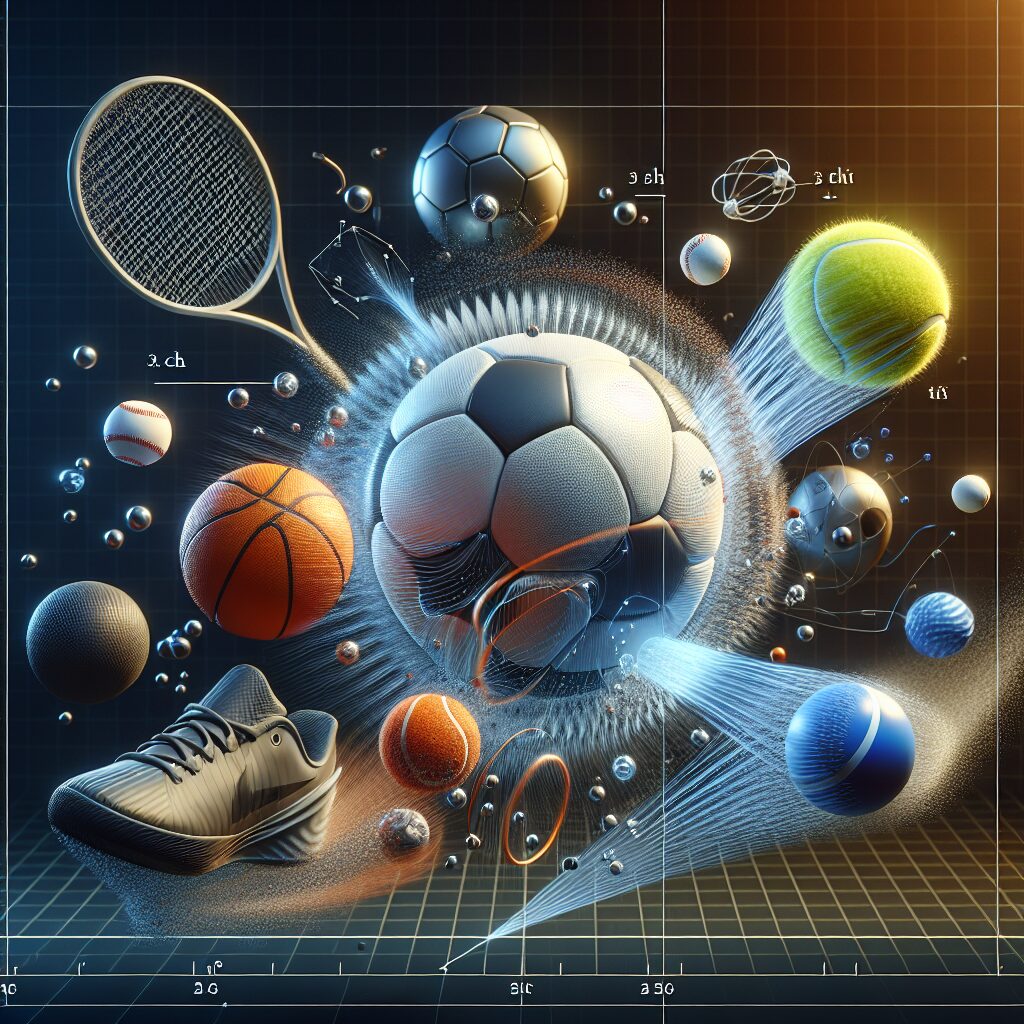Aerodynamics, a branch of fluid dynamics, plays a crucial role in determining the ball speed in various sports. When it comes to sports like golf, tennis, soccer, and baseball, the impact of aerodynamics on the ball’s movements cannot be underestimated. Simply put, aerodynamics refers to the study of how air interacts with objects moving through it. In the context of ball speed, aerodynamics influences factors such as the trajectory, spin, and overall distance covered by the ball.
Understanding the impact of aerodynamics on ball speed is vital for athletes, coaches, and sports enthusiasts alike. For instance, in golf, the design and dimple pattern on a golf ball directly affect its aerodynamic properties. By allowing air to flow smoothly around the ball, the dimples reduce the drag force acting upon it, enabling the ball to fly farther. Similarly, in tennis, the shape of a tennis ball, with its fuzzy felt surface, creates airflow turbulence, resulting in better control and greater power during shots.
In the forthcoming sections, we will delve deeper into the key takeaways related to the impact of aerodynamics on ball speed. We will explore how factors like ball shape, surface texture, and spin can significantly affect the trajectory and distance covered by a ball. By understanding these nuances, athletes can optimize their performance, enhance their accuracy, and ultimately achieve better results in their respective sports. So, let’s dive into the world of ball aerodynamics and uncover the secrets behind maximizing ball speed.
Key Takeaways
1. Aerodynamics significantly affect the speed and trajectory of a ball, impacting its flight path and distance traveled. The shape and surface texture of the ball, as well as external factors like wind, play a crucial role in determining its aerodynamic properties.
2. The surface roughness of the ball affects its drag and lift forces. A smoother surface reduces drag, enabling the ball to travel faster and cover greater distances. Additionally, a rough surface facilitates the creation of turbulent airflow, leading to increased lift and a higher trajectory.
3. The dimples on a golf ball are specifically designed to optimize its aerodynamics. By creating turbulent airflow, dimples reduce drag and increase lift, allowing the ball to maintain a stable flight and maximize its distance. The number, pattern, and depth of dimples all impact the ball’s aerodynamic performance.
4. The Magnus effect, observed in sports such as baseball and tennis, arises from the spin imparted to the ball. This spin creates differences in air pressure around the ball, generating lift or drag forces. By utilizing the Magnus effect, players can control the trajectory and speed of their shots.
5. External factors like wind can significantly influence a ball’s aerodynamic behavior. Wind speed and direction impact both drag and lift forces, altering the flight path and distance of the ball. Understanding and adapting to these conditions is crucial for athletes aiming to optimize their performance and achieve desired outcomes.
Can Aerodynamics Affect the Speed of a Ball?
How Aerodynamics Influence Ball Speed
Aerodynamics plays a crucial role in determining the speed of a ball. Whether it’s a soccer ball, golf ball, or any other sports ball, the way it interacts with the surrounding air can significantly impact its velocity.
Air Resistance and Drag
Air resistance, also known as drag, is the primary aerodynamic force that affects the speed of a ball. As a ball moves through the air, it encounters an opposing force in the form of air molecules. This force of resistance acts against the direction of motion, gradually reducing the ball’s speed.
Shape and Surface Texture
The shape and surface texture of a ball have a profound impact on its aerodynamic properties. A streamlined, smooth surface design minimizes drag, allowing the ball to travel faster through the air. On the other hand, irregularities or rough texture on the ball’s surface increase air resistance, leading to a decrease in speed.
Spin and Lift
Aside from reducing drag, aerodynamics can also generate lift, enabling the ball to experience an upward force. When a ball possesses backspin, it creates a phenomenon called the Magnus effect. This effect creates lift, allowing the ball to stay in the air longer and travel further. In some cases, spin-induced lift can even increase the overall speed of the ball.
Factors Affecting Aerodynamics
Several factors influence the aerodynamics of a ball and, consequently, its speed. These include the ball’s weight, surface material, compression, and even external factors like altitude and air temperature. Each factor affects the aerodynamic forces acting on the ball and can either increase or decrease its speed.
The Influence of Aerodynamics on Different Balls
Soccer Balls
In soccer, the aerodynamic properties of the ball are crucial for determining its speed and trajectory. Modern soccer balls feature a combination of smooth panels and textured areas to optimize their aerodynamics. The panel design aims to reduce drag and increase stability, ensuring that players can accurately control the ball’s speed and direction.
Golf Balls
Golf balls heavily rely on aerodynamics to achieve maximum distance and accuracy. The dimples on a golf ball significantly impact its speed by reducing drag. These dimples create a turbulent boundary layer that allows air to flow more smoothly around the ball, minimizing drag and maximizing lift. Consequently, a properly dimpled golf ball can travel farther and with greater precision.
Tennis Balls
Tennis balls are designed to have a specific level of air resistance to suit the requirements of the game. Manufacturers achieve this by altering the ball’s materials and pressurization. The aim is to strike a balance between increasing the ball’s speed and providing adequate bounce and control. By optimizing the aerodynamics, tennis players can achieve faster shots and enhance their overall performance.
Conclusion
Maximizing Ball Speed with Aerodynamics
Understanding the impact of aerodynamics on ball speed is essential for athletes and sports enthusiasts. By considering factors such as air resistance, ball shape, surface texture, and spin, athletes can aim to optimize the aerodynamic properties of their chosen balls. This knowledge empowers them to make informed decisions when selecting equipment and techniques, ultimately enhancing their performance on the field or course.
Guides to Improve Ball Speed through Aerodynamics:
- How can you select a ball with an aerodynamically optimized shape?
- What techniques can be employed to reduce drag on a ball’s surface?
- Does the spin direction affect lift and the overall speed of the ball?
- What are the effects of different ball weights on its aerodynamic behavior?
- How does varying levels of air compression impact a ball’s speed?
- Are there any measures athletes can take to adjust for the influence of altitude and temperature on ball speed?
Frequently Asked Questions
1. How does aerodynamics affect ball speed?
Aerodynamics plays a crucial role in determining the speed of a ball. The shape, surface texture, and air resistance impact how the ball moves through the air. By reducing drag, aerodynamic designs allow the ball to travel faster and cover greater distances.
2. What is drag and how does it affect ball speed?
Drag refers to the resistance encountered by a ball as it moves through the air. Greater drag results in slower ball speed, reducing both the distance and accuracy of the shot. Optimal aerodynamics minimize drag, allowing the ball to maintain higher speeds for longer periods.
3. How can the shape of a ball impact its speed?
The shape of a ball significantly influences its aerodynamic performance. Smooth, streamlined designs with fewer irregularities create less turbulence and reduce drag. Spherical or symmetrical balls tend to have better stability and maintain speed more effectively compared to irregularly-shaped balls.
4. Does the surface texture affect ball speed?
Absolutely! Surface texture contributes to the boundary layer formation and can substantially impact ball speed. A rough surface, such as the dimples on a golf ball, can create a turbulent boundary layer, which reduces drag and allows the ball to travel faster through the air.
5. Are all sports balls designed with aerodynamics in mind?
Most modern sports balls, especially those involving aerial movement, are engineered with aerodynamics as a primary consideration. Soccer balls, baseballs, tennis balls, and golf balls are just a few examples of sports equipment designed to optimize aerodynamic properties for enhanced performance.
6. How do manufacturers test and optimize the aerodynamics of a ball?
Ball manufacturers employ various techniques to evaluate and refine the aerodynamics of their products. This includes wind tunnel testing, computer simulations, and real-world experiments. By analyzing the ball’s behavior in different conditions, manufacturers can fine-tune its design to maximize speed and control.
7. Can an understanding of aerodynamics help players improve their performance?
Yes, having a basic understanding of aerodynamics can definitely benefit players. With knowledge about drag, lift, and other aerodynamic factors, athletes can make educated decisions about ball selection and technique. This can lead to improved performance, better control, and ultimately, higher ball speeds.
8. Is it possible to modify ball aerodynamics to suit personal preferences?
In some cases, it is possible to modify ball characteristics to suit personal preferences. For example, golfers can experiment with different ball models that offer varying degrees of spin and flight stability. However, it’s important to note that any modifications should be made within the rules and regulations of the sport.
9. Can weather conditions impact the aerodynamics of a ball?
Absolutely! Weather conditions, particularly wind speed and direction, can significantly affect the aerodynamics of a ball. Strong headwinds can increase drag and reduce ball speed, while tailwinds can provide an additional push, resulting in higher speeds. Players need to consider such conditions when attempting long shots.
10. How do advancements in aerodynamics technology impact ball design?
Advancements in aerodynamics technology continually push the boundaries of ball design. Manufacturers are constantly exploring innovative concepts to optimize performance. These advancements can lead to improved ball speed, stability, and control, benefiting both professional athletes and recreational players alike.
Final Thoughts
The impact of aerodynamics on ball speed cannot be overstated. It is a critical factor that affects the performance and outcomes of various sports. By understanding how aerodynamics influence ball movement, athletes can make informed decisions regarding their equipment and technique.
Advancements in aerodynamic research and technology contribute to the evolution of sports balls, helping athletes achieve new levels of performance. Manufacturers continue to invest in developing innovative designs to enhance ball speed, control, and overall playability. As athletes and sports enthusiasts, embracing the principles of aerodynamics can unlock new possibilities and help us experience the thrill of pushing the limits of our chosen games.




